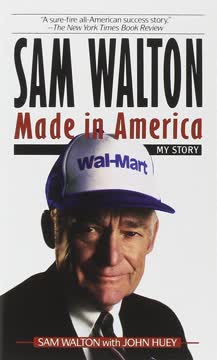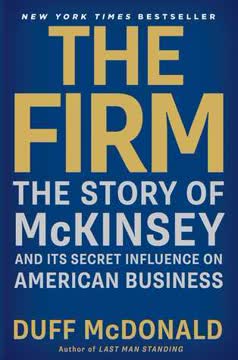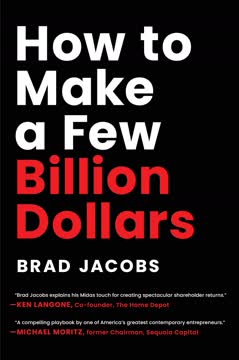نکات کلیدی
1. نقاط عطف استراتژیک میتوانند یک کسبوکار را بسازند یا نابود کنند
نقطه عطف استراتژیک زمانی در زندگی یک کسبوکار است که اصول بنیادی آن در شرف تغییر است.
لحظه تعیینکننده. نقاط عطف استراتژیک لحظات محوری هستند که میتوانند به رشد بیسابقه یا افت سریع منجر شوند. این نقاط زمانی رخ میدهند که تعادل نیروها از روشهای قدیمی کسبوکار به روشهای جدید تغییر میکند. این تغییرات میتوانند به دلایل مختلفی ایجاد شوند:
- پیشرفتهای تکنولوژیکی
- تغییرات در رقابت
- تغییرات در ترجیحات مشتریان
- مقررات جدید
تشخیص علائم. شناسایی زودهنگام یک نقطه عطف استراتژیک بسیار مهم است. علائم ممکن است شامل موارد زیر باشند:
- رقابت غیرمنتظره از سوی تازهواردان
- کاهش سهم بازار یا سودآوری
- تغییرات در رفتار مشتریان
- ظهور فناوریهای مخرب در صنعت شما
اقدام کردن. موفقیت در عبور از یک نقطه عطف استراتژیک نیازمند اقدام قاطعانه است، اغلب قبل از اینکه تأثیر کامل آن مشخص شود. این ممکن است شامل موارد زیر باشد:
- بازنگری در مدل کسبوکار
- تخصیص مجدد منابع
- توسعه قابلیتهای جدید
- اتخاذ تصمیمات سخت درباره خطوط تولید یا بازارها
2. شناسایی و تطبیق با تغییرات "10X" در صنعت خود
زمانی که تغییری در نحوه انجام برخی عناصر کسبوکار به اندازهای بزرگتر از آنچه که کسبوکار به آن عادت دارد، رخ میدهد، همه چیز تغییر میکند.
نیروی مخرب. تغییر "10X" نیرویی است که به قدری قدرتمند است که به طور بنیادی چشمانداز رقابتی را تغییر میدهد. این تغییرات میتوانند از منابع مختلفی ناشی شوند:
- پیشرفتهای تکنولوژیکی
- تازهواردان بازار با مدلهای کسبوکار کاملاً متفاوت
- تغییرات مقرراتی که مرزهای صنعت را بازتعریف میکنند
ارزیابی تأثیر. هنگام مواجهه با یک تغییر "10X" بالقوه، از خود بپرسید:
- این چگونه بر مدل کسبوکار فعلی ما تأثیر میگذارد؟
- چه فرصتهای جدیدی ایجاد میکند؟
- چه مهارتها یا داراییهای موجود ممکن است منسوخ شوند؟
- با چه سرعتی باید تطبیق پیدا کنیم؟
پاسخ استراتژیک. تطبیق با یک تغییر "10X" اغلب نیازمند بازاندیشی کامل کسبوکار شماست. این ممکن است شامل موارد زیر باشد:
- توسعه شایستگیهای اصلی جدید
- ورود به بازارها یا بخشهای مشتری جدید
- تشکیل شراکتهای استراتژیک یا خریدها
- تغییر بنیادی در پیشنهاد ارزش شما
3. پرورش فرهنگ مواجهه سازنده و بحث
من به ارزش پارانویا اعتقاد دارم. موفقیت در کسبوکار بذرهای نابودی خود را در بر دارد.
ارتباط باز. محیطی را ایجاد کنید که در آن کارکنان در همه سطوح احساس راحتی کنند که ایدهها را به چالش بکشند و نگرانیها را بیان کنند. این کمک میکند به:
- شناسایی تهدیدهای بالقوه در مراحل اولیه
- تولید راهحلهای نوآورانه
- اجتناب از تفکر گروهی و رضایتمندی
تشویق به تنوع. افراد با دیدگاهها و پیشینههای مختلف را گرد هم آورید تا:
- دامنه ایدهها و بینشها را گسترش دهید
- فرضیات و حکمتهای متعارف را به چالش بکشید
- نقاط کور در استراتژی خود را شناسایی کنید
بحث ساختاریافته. فرآیندهایی برای بحث سازنده پیادهسازی کنید:
- جلسات منظم بررسی استراتژی
- تیمهای حل مسئله بینوظیفهای
- مکانیزمهای بازخورد ناشناس
- نقشهای "وکیل مدافع شیطان" در تصمیمگیری
4. اجازه دهید هرج و مرج حاکم شود، سپس در دوران گذار هرج و مرج را مهار کنید
حل و فصل از طریق آزمایش به دست میآید. تنها با خروج از مسیرهای قدیمی، بینشهای جدید به دست میآید.
پذیرش عدم قطعیت. در زمانهای تغییرات قابل توجه، بسیار مهم است که:
- آزمایش و ریسکپذیری را تشویق کنید
- اجازه دهید دورهای از "هرج و مرج کنترلشده" وجود داشته باشد
- به طور همزمان گزینههای متعددی را بررسی کنید
مراحل گذار:
-
اجازه دهید هرج و مرج حاکم شود:
- ایدهها و رویکردهای متنوع را تشویق کنید
- منابع را به ابتکارات آزمایشی متعدد اختصاص دهید
- سطح بالاتری از عدم قطعیت و ابهام را تحمل کنید
-
هرج و مرج را مهار کنید:
- نتایج آزمایشها را ارزیابی کنید
- یادگیریها و بهترین شیوهها را تثبیت کنید
- منابع را بر روی جهتهای امیدوارکننده متمرکز کنید
- راهنمایی و جهتگیری واضح ارائه دهید
تعادل و زمانبندی. کلید موفقیت دانستن زمان تغییر از مرحله هرج و مرج به مرحله تمرکز است. این نیازمند:
- ارزیابی مداوم شرایط بازار
- معیارهای واضح برای ارزیابی آزمایشها
- رهبری قوی برای اتخاذ تصمیمات سخت
5. آزمایش کنید و از تغییرات تکنولوژیکی جلوتر بمانید
نمیتوانید اهمیت نقاط عطف استراتژیک را با کیفیت نسخه اول قضاوت کنید.
نوآوری مداوم. در خط مقدم تغییرات تکنولوژیکی باقی بمانید با:
- تخصیص منابع به تحقیق و توسعه و نوآوری
- تشویق فرهنگ آزمایش
- نظارت بر فناوریها و روندهای نوظهور
پذیرش زودهنگام. آماده باشید تا با فناوریهای جدید آزمایش کنید، حتی اگر هنوز کامل نیستند:
- برنامههای آزمایشی برای فناوریهای امیدوارکننده
- شراکت با استارتاپهای نوآور
- پروژههای داخلی "اسکانکورکس"
یادگیری از شکستها. شکستها را به عنوان فرصتهای یادگیری بپذیرید:
- بررسیهای دقیق پس از مرگ بر روی آزمایشهای ناموفق انجام دهید
- درسهای آموخته شده را در سراسر سازمان به اشتراک بگذارید
- بر اساس بازخورد و نتایج، تکرار و بهبود کنید
6. وضوح جهتگیری در هنگام هدایت تغییرات بسیار مهم است
وضوح جهتگیری، که شامل توصیف آنچه که به دنبال آن هستیم و همچنین توصیف آنچه که به دنبال آن نخواهیم بود، در مرحله پایانی یک تحول استراتژیک بسیار مهم است.
چشمانداز و تمرکز. در زمانهای تغییرات قابل توجه، راهنمایی واضحی ارائه دهید در مورد:
- جهتگیری و اولویتهای جدید شرکت
- آنچه که سازمان دنبال خواهد کرد و نخواهد کرد
- نقاط عطف کلیدی و معیارهای موفقیت
استراتژی ارتباطی. اطمینان حاصل کنید که جهتگیری جدید در سراسر سازمان درک شده است:
- پیامرسانی مکرر و مداوم از سوی رهبری
- جلسات عمومی و جلسات پرسش و پاسخ
- ارتباطات کتبی (یادداشتها، ایمیلها، نشریات داخلی)
- تقویت از طریق مدیریت عملکرد و مشوقها
همراستایی منابع. جهتگیری جدید را با اقدامات ملموس پشتیبانی کنید:
- بودجه و پرسنل را به مناطق اولویتدار اختصاص دهید
- فعالیتهای غیر اصلی را واگذار یا متوقف کنید
- ساختار سازمانی را برای حمایت از اولویتهای جدید تنظیم کنید
- در توسعه قابلیتها و مهارتهای جدید سرمایهگذاری کنید
7. شغل شما کسبوکار شماست - برای نقاط عطف آماده باشید
شغل شما به معنای واقعی کلمه کسبوکار شماست. شما به عنوان یک مالک انحصاری آن را دارید.
مسئولیت شخصی. مالکیت توسعه شغلی خود را بر عهده بگیرید:
- به طور مداوم مهارتها و ارزش بازار خود را ارزیابی کنید
- از روندها و اختلالات صنعت مطلع باشید
- در یادگیری و توسعه مهارتهای مداوم سرمایهگذاری کنید
نقاط عطف شغلی. برای تغییرات قابل توجه در شغل خود آماده باشید:
- علائم تغییر در صنعت یا نقش خود را شناسایی کنید
- شبکهای ایجاد کنید که بتواند دیدگاههای متنوعی ارائه دهد
- یک "طرح ب" داشته باشید و در صورت لزوم آماده تغییر باشید
مدیریت شغلی پیشگیرانه:
- به طور منظم مهارتها و دانش خود را بهروزرسانی کنید
- به دنبال چالشها و مسئولیتهای جدید باشید
- برند و شهرت شخصی خود را در زمینه خود بسازید
- انعطافپذیری مالی برای گذر از انتقالها را حفظ کنید
- آماده باشید تا برای فرصتهای رشد ریسکهای محاسبهشدهای بپذیرید
آخرین بهروزرسانی::
FAQ
What's "Only the Paranoid Survive" about?
- Author and Focus: Written by Andrew S. Grove, the book explores how businesses can navigate and exploit crisis points, termed as "strategic inflection points," that challenge their existence.
- Concept of Paranoia: Grove emphasizes the importance of paranoia in business, suggesting that constant vigilance and readiness for change are crucial for survival.
- Strategic Inflection Points: The book delves into how these points represent fundamental changes in business environments that can lead to either growth or decline.
- Real-World Examples: Grove uses his experiences at Intel to illustrate how companies can identify and respond to these critical changes.
Why should I read "Only the Paranoid Survive"?
- Insightful Business Strategies: The book provides practical strategies for recognizing and responding to major changes in the business environment.
- Real-Life Applications: Grove shares personal experiences and case studies from Intel, offering valuable lessons applicable to various industries.
- Understanding Change: It helps readers understand the dynamics of change and how to leverage them for competitive advantage.
- Leadership Lessons: The book offers insights into effective leadership during times of crisis and transformation.
What are the key takeaways of "Only the Paranoid Survive"?
- Embrace Change: Businesses must be prepared to adapt to significant changes in their environment to survive and thrive.
- Identify Inflection Points: Recognizing strategic inflection points early can provide opportunities for growth and prevent decline.
- Importance of Debate: Engaging in broad and intensive debate is crucial for distinguishing between signal and noise in business changes.
- Role of Leadership: Strong leadership is essential in guiding organizations through periods of uncertainty and transformation.
What is a "strategic inflection point" according to Andrew S. Grove?
- Definition: A strategic inflection point is a moment when the fundamentals of a business are about to change, which can lead to new opportunities or signal the beginning of the end.
- Causes: These points can be triggered by technological changes, shifts in competition, or changes in customer behavior.
- Impact: They require businesses to adapt their strategies and operations to align with the new environment.
- Examples: Grove uses Intel's transition from memory chips to microprocessors as a case study of navigating a strategic inflection point.
How does Andrew S. Grove suggest businesses handle strategic inflection points?
- Recognize Early Signs: Businesses should be vigilant and recognize early signs of change in their environment.
- Engage in Debate: Encourage open debate within the organization to clarify whether changes are significant or just noise.
- Experimentation: Allow for experimentation and chaos to explore new directions and solutions.
- Decisive Action: Once a new direction is clear, take decisive action to align resources and efforts with the new strategy.
What role does paranoia play in business according to "Only the Paranoid Survive"?
- Constant Vigilance: Paranoia in business means being constantly vigilant and aware of potential threats and changes in the environment.
- Prevent Complacency: It helps prevent complacency, ensuring that businesses are always prepared to adapt and respond to new challenges.
- Drive for Improvement: Paranoia can drive continuous improvement and innovation, keeping businesses competitive.
- Leadership Mindset: Leaders should instill a sense of paranoia in their teams to maintain a proactive and responsive organizational culture.
What are the "Six Forces" affecting a business as described by Grove?
- Existing Competitors: The power and competence of current competitors in the market.
- Suppliers: The influence and bargaining power of suppliers on a business.
- Customers: The demands and power of customers in shaping business strategies.
- Potential Competitors: The threat posed by new entrants into the market.
- Substitution: The risk of products or services being replaced by alternatives.
- Complementors: Businesses that offer complementary products or services that enhance a company's offerings.
How did Intel navigate its strategic inflection point according to Grove?
- Memory to Microprocessors: Intel shifted its focus from memory chips to microprocessors, recognizing the latter's potential for growth.
- Leadership Decision: Grove and Intel's leadership made the difficult decision to exit the memory business despite its historical significance to the company.
- Resource Reallocation: Intel reallocated resources and talent to support the burgeoning microprocessor business.
- Cultural Shift: The company embraced a new identity as a microcomputer company, aligning its strategy and operations with this vision.
What are some of the best quotes from "Only the Paranoid Survive" and what do they mean?
- "Only the paranoid survive." This quote encapsulates the book's central theme that constant vigilance and readiness for change are essential for business survival.
- "Business success contains the seeds of its own destruction." Success can lead to complacency, making businesses vulnerable to new threats and changes.
- "A strategic inflection point is a time in the life of a business when its fundamentals are about to change." This highlights the critical nature of recognizing and responding to major shifts in the business environment.
- "Let chaos reign, then rein in chaos." Encourages experimentation and exploration during times of change, followed by decisive action to establish order and direction.
How can businesses distinguish between signal and noise in changes?
- Broad Debate: Engage in broad and intensive debate within the organization to assess the significance of changes.
- Cassandras: Listen to the Cassandras, or those who are quick to recognize impending change and provide early warnings.
- Avoid First Version Trap: Don't judge the significance of changes based on the quality of the first version; consider the potential for improvement.
- Continuous Monitoring: Keep changes on the radar and continuously monitor their development to determine if they represent a strategic inflection point.
What lessons can individuals learn from "Only the Paranoid Survive" for their careers?
- Career as a Business: Treat your career as a business, taking responsibility for its direction and success.
- Adaptability: Be prepared to adapt to changes in your industry or role to remain competitive.
- Proactive Planning: Engage in proactive planning and experimentation to prepare for potential career inflection points.
- Continuous Learning: Invest in continuous learning and skill development to stay relevant in a changing environment.
How does Grove's experience at Intel illustrate the book's concepts?
- Real-World Application: Grove uses Intel's transition from memory chips to microprocessors as a case study to illustrate the concepts of strategic inflection points and business transformation.
- Leadership Challenges: He shares the leadership challenges faced during this transition, including decision-making, resource allocation, and cultural shifts.
- Success Story: Intel's successful navigation of its strategic inflection point serves as a testament to the effectiveness of Grove's strategies and insights.
- Lessons Learned: Grove reflects on the lessons learned from this experience, providing valuable insights for other businesses facing similar challenges.
نقد و بررسی
کتاب فقط پارانوئیدها زنده میمانند به بررسی نقاط عطف استراتژیک در کسبوکار و چگونگی مدیریت آنها میپردازد. گروو بر اهمیت شناسایی تغییرات صنعت، گوش دادن به مدیریت میانی و تطبیق سریع تأکید میکند. خوانندگان از بینشهای گروو که از تجربهاش در اینتل به دست آمده، قدردانی میکنند اما برخی از توصیهها را سادهانگارانه میدانند. مفاهیم نیروهای 10 برابری و پارانویا در این کتاب با بسیاری، بهویژه در حوزه فناوری، همخوانی دارد. در حالی که برخی آن را قدیمی میدانند، دیگران به ارتباط پایدار آن در محیط کسبوکار پرشتاب امروزی اذعان دارند. بهطور کلی، این کتاب بهعنوان یک مطالعه ارزشمند برای کارآفرینان و مدیران اجرایی محسوب میشود.
Similar Books















